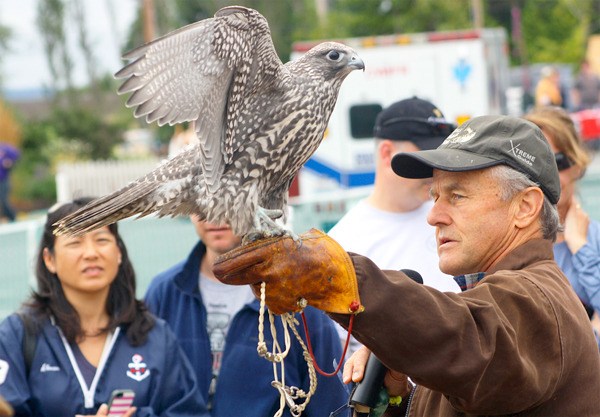Steve Layman was no ordinary teenager.
Rather than taking an interest in hot rods or baseball, Layman was captivated with studying, observing and befriending birds of prey.
His fascination began in childhood when, growing up on the Yakama Indian Reservation, he and his friends aimed to emulate falcons, hoping to one day become great hunters.
“The hawks and eagles were hunters … and so, as hunters and gatherers, we were out there playing the game,” he said during a recent presentation at Greenbank Farm.
Little else held his attention, Layman recalled, but watching the birds held him rapt for hours.
It wasn’t long before Layman had trained his first bird, establishing a relationship with the hawk which contained no fear from either party.
In order to capture his first raptor, Layman stole the bird’s rabbit. The second time, he took half of the bird’s prey, leaving some behind. It’s a technique he said has been used for some time.
It was only a matter of time before the bird began to follow him.
“We have an instinctual, intellectual understanding of the process,” he said. Raptors are able to recognize individual people, and come to view him as a dependable and trustworthy source of food.
Gleaning inspiration from T.H. White’s book “The Goshawk” and a National Geographic article entitled “The Sport of Kings,” Layman quickly developed an interest in the craft of falconry.
Today, Layman is an expert falconer, a raptor biologist and an educator.
“It’s a natural history lifestyle,” he said.
At his home, he has nine raptors, some of which are employed at several Whidbey Island farms, including Mutiny Bay Blues in Freeland. The raptors intimidate the smaller birds who would otherwise steal away with snacks of blueberries or other produce.
Layman has also assisted with a project employing raptors in scaring away smaller birds who enjoy swiping food from a five-star restaurant in Georgia.
Many of the birds accompany Layman for hunting, or for educational presentations.
One of the indicators of a great falconer, he said, is the falconer’s ability to let a bird go free and see that bird return.
Often, Layman’s birds soar off in solitude for weeks or months at a time, but always return.
It’s a sort of symbiotic relationship, he said.
During his presentation, Layman took a moment to feed the bird he had brought with him after noticing the hawk appeared hungry.
“He thinks I’m his mom,” Layman explained to a group of attentive children in the front row.
Layman said that humans have been hunting with raptors for more than 2,000 years.
During the Renaissance, falconry was practiced throughout by both farmers and nobility.
Recently, the craft has experienced a boom, he said.

“If I were younger I think I would consider getting into (falconry),” said Jerry Lloyd, a friend of Layman’s.
“He’s brilliant at this,” Lloyd said of Layman.
With the advancement of technology, the knowledge of raptors and their capabilities has also greatly increased.
With the use of small GPS tracking devices attached to the bird’s back, researchers have been able to calculate raptors’ speed and height while flying.
“It’s a real exciting time for us,” he said.
About 10 years ago, Layman and fellow falconers trained birds to fly from helicopters, following the descent of skydivers.
Through their studies, they found that falcons can reach a speed of 240 miles per hour, though Layman said it is speculated that they may actually reach speeds of up to 300 miles per hour, though that has not yet been quantified.
Layman was able to record a female peregrine falcon ascending to approximately 6,000 and 10,000 feet using the radio transmitters.
Although he has partnered with raptors for both business and pleasure for decades, Layman said he still finds the experience of being in their presence “humbling.”
“As a biologist I’ve been interested in the wild, where there are no people. As I have grown and matured, I have realized that the future of wildlife is in close proximity to people,” he said.
Particularly on Whidbey Island, wildlife is observable from most residents’ backyards.
Osprey take periodically roost on telephone poles; owls can frequently be heard cooing in the night; falcons line the fences of farms outside of Coupeville.
Layman noted that the island has become more biologically diverse ever since he first moved here 25 years ago, and said the amount of predators and scavengers is a good sign of a healthy ecosystem.
“We’ve got the leisure to appreciate things like this now, instead of competing with it,” Layman said.


